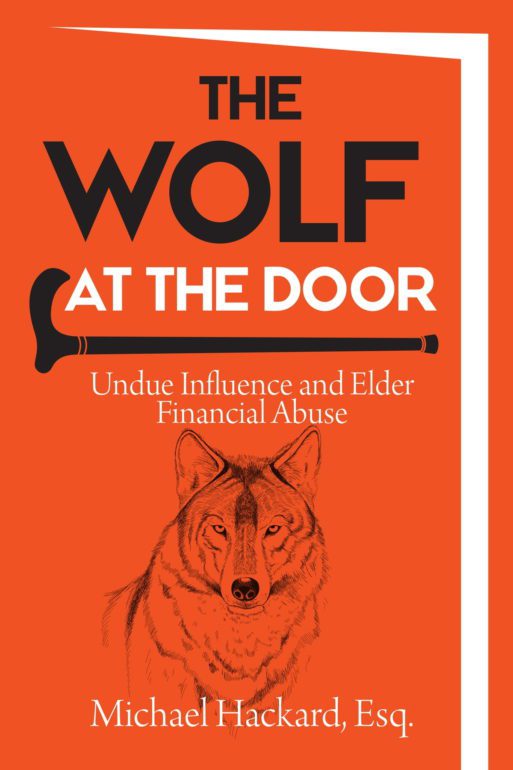 “The Wolf at the Door: Undue Influence and Elder Financial Abuse,”written by California attorney Michael Hackard, tackles a painful and dark aspect of aging — elder financial abuse. His book addresses the population of over 75 million Baby Boomers, who are either close to or already in the midst of retirement. As this sizable population ages, it could mean big opportunities for elder exploitation.
“The Wolf at the Door: Undue Influence and Elder Financial Abuse,”written by California attorney Michael Hackard, tackles a painful and dark aspect of aging — elder financial abuse. His book addresses the population of over 75 million Baby Boomers, who are either close to or already in the midst of retirement. As this sizable population ages, it could mean big opportunities for elder exploitation.
Hackard is well informed — His family was victimized by elder financial abuse. Since then, he has directed his attention and law practice towards defending and protecting other victims. This book is result of his experiences and research, and acts a guidebook for awareness and prevention.
From the get-go, Hackard explains the financial and emotional damage that elder abuse can inflict on families, communities and the economy. The estimated nationwide cost of elder financial abuse is set at nearly $3 billion a year, though other researchers have set the figure much higher. This could be, as one study found, because only 7 percent of elder abuse cases ever come to the authorities. This severe under-reporting could be due to the victim’s isolation, shame, or failing memory; the fraudster’s cover-ups; or the belief by the victim’s caregivers that “it is too late.” When cases are reported, these same factors can add to the difficulty of prosecuting such offenses.
Hackard posits that the first task in addressing elder financial abuse is recognition. Awareness and empowerment are the driving force behind the book, as stated in the introduction: “My goal is to help you understand the legal basis for elder financial abuse and provide you with some tools for getting the appropriate help.”
Wolf at the Door Insights
The book includes case studies, research, lessons, and anecdotes from Hackard’s experiences representing victims. It is practical in nature with applicable information throughout. The introduction and first two chapters explain the basics of fraud, elder financial abuse, and undue influence, and also provide real-life examples of the most common ways elder financial abuse occurs. Every presentation of a problem is matched with a thorough listing of how to recognize, prevent, and combat such exploitation.

In Chapter 3, Hackard highlights the special vulnerability of those with Alzheimer’s and dementia, explaining the disease in the light of estate litigation and the question of capacity. He provides his own protocol for litigating such cases, outlining what is specifically needed in an elder abuse case in which the victim has Alzheimer’s or dementia.
Hackard devotes the following chapters to providing instructions, tools, and techniques to legally combat elder financial abuse. These include the details of finding an attorney, litigation strategy, proving undue influence, mediation as resolution, and more.
Final Thoughts
The book is thorough in scope, and can be redundant on occasion — if only to hammer home the point that elder financial abuse is pervasive and multifaceted. The book is easy to understand and comprehend — one does not need to understand legalese to glean valuable insight.
Hackard provides excellent citations for all of his statistics and figures, which are listed in the back of the book. He is honest and consistent about the effort it takes to protect yourself and loved ones from elder financial abuse. Chapter 1 ends with this: “Protecting your elderly family member is virtually a full-time job…We can embrace these duties with love, but it is a love often coupled with real sacrifice.”
The book can appear intimidating. Its bright red cover and shrewd wolf illustration sets off alarms in one’s head. However, it serves Michael Hackard’s point: Elder financial abuse can happen to anyone, and arming oneself with knowledge is the best way to fight it.

 “The Wolf at the Door: Undue Influence and Elder Financial Abuse” by Michael Hackard
“The Wolf at the Door: Undue Influence and Elder Financial Abuse” by Michael Hackard


 Funeral Home Owner Chris Johnson Spending Halloween in Jail
Funeral Home Owner Chris Johnson Spending Halloween in Jail
 Our Monthly Tip: Toast a Loved One with a Personalized Glass
Our Monthly Tip: Toast a Loved One with a Personalized Glass
 My Cousin’s Death Taught Me the Meaning of Life
My Cousin’s Death Taught Me the Meaning of Life















We settled out of court (North San Diego County) and were told that we could not discuss the case or settlement with media, etc. As a retired Social Worker, I wanted to help other elderly people, who may have been unduly influenced. We hated signing the settlement, but our attorney advised us to take the deal. Doesn’t the public have the right to all court records? So,
if someone contacts me about our experience, can we discuss it. I believe the settlement was in 2008.
Report this comment